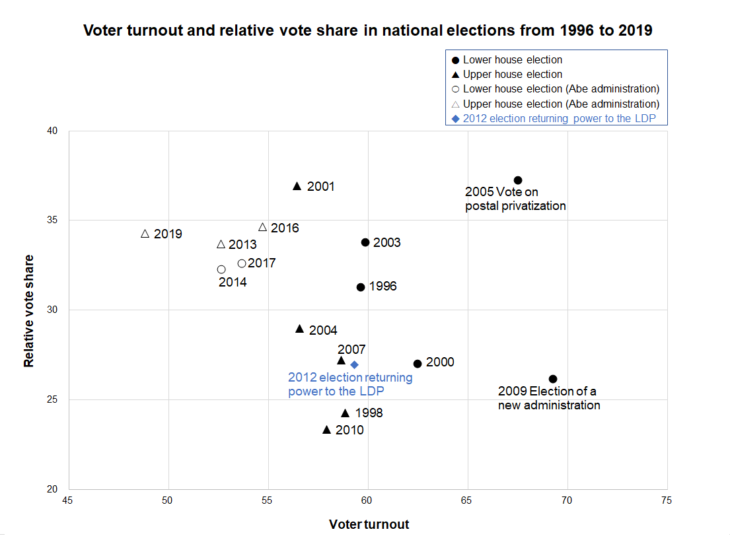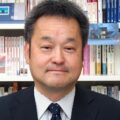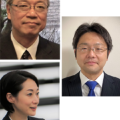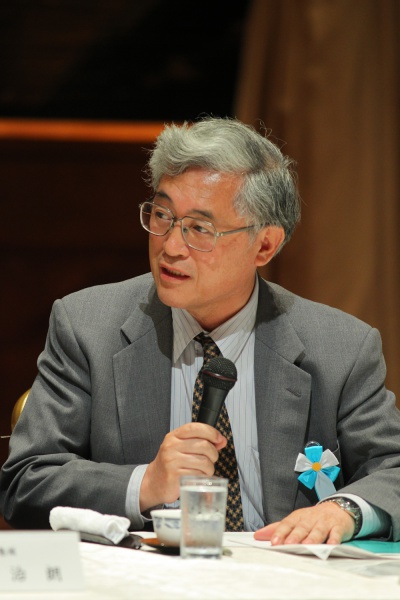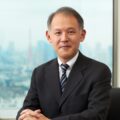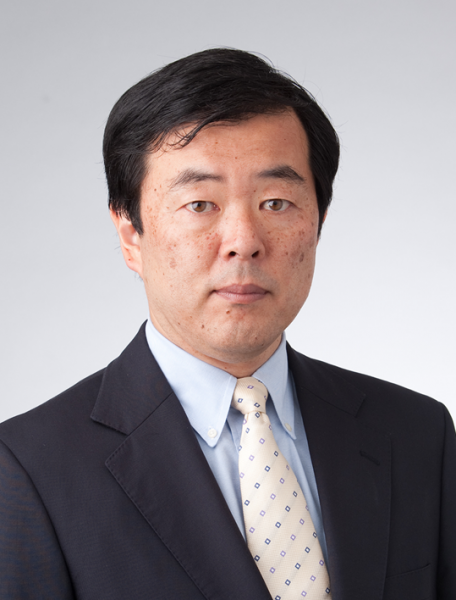Challenges Facing the New Government: Thorough Explanations Needed for Prioritizing Specific Issues
Kohno Masaru, Professor, Waseda University
Key points
- Abe ikkyo, the phenomenon that describes the political dominance of the former Prime Minister Abe Shinzo, was supported by a low voter turnout rate
- Explanation is needed for why pressuring mobile phone companies to lower fees is compatible with the principle of regulatory reform
- The question of how to define getting COVID-19 “under control” is difficult
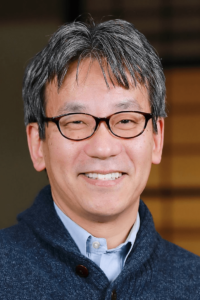
Prof. Kohno Masaru
The Suga Yoshihide government has been formed. At his first press conference as Prime Minister, Suga spoke frankly about his sense of responsibility to carry on the efforts of his predecessor Abe Shinzo who fell ill while leading the fight against the coronavirus, as well as his conviction and determination to strike a balance with economic revitalization even amid concern over growing infections. Suga was also praised for quickly announcing a set of concrete policy goals: lowering mobile phone fees, establishing an agency in charge of digital transformation, and providing insurance coverage for fertility treatments. Various opinion polls have since reported high approval ratings.
As the term “honeymoon effect” suggests, it is not rare for a newly formed government to enjoy a high level of public support. Having said that, Suga may have a chance to stay in power longer than his interim term as President of the Liberal Democratic Party (LDP), which ends in September 2021. For Suga, who lacks a strong base within his own party, victory in the next general election would most likely ensure that.
The above figure plots voter turnout and the LDP’s relative share of the proportional representation vote in national elections from 1996 onward. Relative vote share is calculated using the number of people who actually voted as the denominator. The figure reveals that a low turnout benefits the LDP. The only exception where the LDP won big despite a high turnout was the so-called postal privatization election in 2005. That anomaly aside, it can be estimated that for every 1 percent drop in turnout, the LDP’s relative vote share rose by approximately 0.5 points. Particularly noteworthy is the tendency that recent elections are all clustered in the upper left corner of the chart. This suggests evidently that the Abe ikkyo phenomenon was supported by a low voter turnout.
It is difficult to imagine voter turnout drastically improving in the near future. Concerns over coronavirus infections will likely drive voter turnout down. On top of that, so far there is no sign of rising expectations sympathetic to the Constitutional Democratic Party of Japan (CDP) or any other parties in the opposition, as an alternative to the LDP, which would otherwise motivate people to go to the poll. The next general election for the lower house must be held by October 2021, when the representatives’ terms end. Objectively speaking, regardless of exactly when the election is held, the LDP is almost certain to win it, making it rather likely that Suga will continue to lead the government.
Given this future prospect, it is warranted that Suga as the nation’s leader lay out clearly and systematically what kind of society he aims to build in his first policy speech at the extraordinary Diet session to be convened in late October. In the previous press conferences, Suga has used the phrase “self-help (jijo), mutual help (kyojo), public help (kojo), and bonds (kizuna)”. What the public wants to know is Suga’s ideas and vision about what the balance between these should be.
Today, there appears to be a tendency to discredit discussing abstract ideas as the work of irresponsible commentators and instead to value practical ability to solve specific problems. Suga himself is said to favor the particular over the general and reality over ideals. However, individual problems that need to be solved must somehow be interconnected in a larger conceptual scheme. Otherwise, it won’t be possible to evaluate a rationale for why addressing a particular issue should be prioritized, nor to determine whether different approaches used for solving problems are compatible with each other.
Take Suga’s call for lowering mobile phone fees, for example. While this is a policy welcomed by most of the public, on what basis such a call is justified is not at all clear. If the oligopoly maintained by the existing three major mobile carriers represents one of the powerful vested interests, and the dismantling of this structure is targeted as an objective, the policy emphasis must remain on the principle of regulatory reform that promotes competition and new entrants. His explicit insistence, on the other hand, that “mobile phone fees be lowered by 40%” may be interpreted as a message indicating that the oligopoly is acceptable as long as fees are lowered.
How, in Suga’s overall vision, does a policy that seeks to force private companies to lower their prices reconcile with regulatory reform, which he proudly declares is “right in the middle” of his governmental platform? This deserves a detailed explanation.
Similarly, the purpose of establishing the digital agency is not transparent. What Suga stressed originally was the need to promote wider usage of the so-called My Number Card, or the Social Security and Tax Number System. However, to have a significant impact, it would be necessary to go beyond the narrowly conceived “digitized administration” and to opt more broadly for “digitized society,” which would have direct and transformative effects in such areas as welfare, education, disaster prevention, and public order among others. Thus, the new government needs to explain, in terms that ordinary people can understand, what kind of society it wants to create through digitization, as well as how it plans to address the problem of “digital divide” that is bound to widen as a result.
Perhaps the most controversial amongst the already announced policy goals is insurance coverage for fertility treatments. Setting aside the fundamental question of whether infertility can be defined as a disease and the policy’s cost effectiveness linked to the success rate of treatments, I am of the view that, if the details of fertility treatment services can be standardized, then extending wider assistance to “patients” who wish to have children is justified from the perspective of fairness.
However, I am quite discontent with the way this policy has been pronounced as part of measures to address the declining birthrate. This is a policy targeted at those who already wish to have children, seeking to ease the constraints and burdens placed upon them. A truly effective countermeasure, which would halt and reverse the trend, has to be something that would induce a more fundamental behavioral change, that is, a policy that would foster an environment where people who never wanted children would want them.
This would require a vision and power for conceptualization, with which to design a society that has not yet been achieved—a society in which any young woman would feel comfortable having children, in which women would not need to quit their jobs to raise children, and in which women’s career advancement would not be delayed due to maternity leave. How would Suga’s self-help, mutual help and public help play each of their roles in such a society? As a matter of political responsibility, this point has to be elaborated.
What the public most earnestly hopes, and what is also Suga’s top priority, is getting COVID-19 under control. This must be the goal in the short run, of course. Note, however, infections can start to rise again even after appearing to be under control, as we observed in countries such as South Korea and New Zealand that had ostensibly succeeded in combatting COVID-19. Suga has pledged to secure enough vaccine for the entire population by the first half of 2021. With the provision of vaccines to the public, it is worth considering removing COVID-19 from the list of “designated infectious diseases” and treating it in the same way as influenza and similar diseases. In any case, how to define a situation where the virus is “under control” remains a difficult question, which the new government will be forced to address in its policy decision.
Even if the government gets COVID-19 completely under control domestically, there will be no return, needless to say, to our previous daily lives predicated on globalization, unless infections are contained throughout the world.
In the short term, this cold, hard fact casts a shadow over deciding what form the postponed Olympics and Paralympics will take. In the longer term, it imposes a challenging task of transforming business models and economic structures whose break-even points rely on inbound demand (of foreign visitors). The Suga administration will have to pay for the debt of previous administrations, as they have put off and failed to tackle the country’s most important problems, namely the decline of the national population and its excessive concentration in the Tokyo metropolitan area.
Translated by The Japan Journal, Ltd. The article first appeared in the “Keizai kyoshitsu” column of The Nikkei newspaper on October 6, 2020 under the title, “Shinseiken no kadai (I): Tokutei no mondai kanyo, setsumei teineini (Challenges facing new government (1): Thorough explanations needed for prioritizing specific issues).” The Nikkei, October 6, 2020. (Courtesy of the author).
Keywords
- Kohno Masaru
- Waseda University
- Abe ikkyo
- Prime Minister Abe
- Prime Minister Suga
- oligopoly
- mobile phone fees
- regulatory reform
- Liberal Democratic Party
- LDP
- kizuna (bonds)
- digitization
- fertility treatment
- COVID-19
- Tokyo Olympics and Paralympics
- population decline
- excessive concentration
